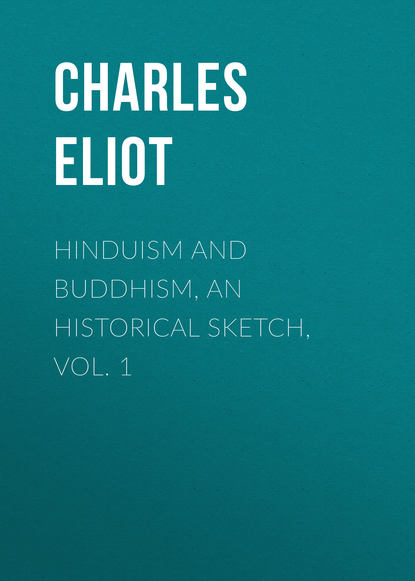По всем вопросам обращайтесь на: info@litportal.ru
(©) 2003-2024.
✖
Hinduism and Buddhism, An Historical Sketch, Vol. 1
Автор
Год написания книги
2018
Настройки чтения
Размер шрифта
Высота строк
Поля
0This impersonality is perhaps a later characteristic. The original form of the Chinese character for T'ien Heaven represented a man. The old Finnish and Samoyede names for God—Ukko and Num—perhaps belong to this stage of thought.
105
0See the account of the Faunus message in this book.
106
0The chief exception in Sanskrit is the Râjataranginî, a chronicle of Kashmir composed in 1148 A.D. There are also a few panegyrics of contemporary monarchs, such as the Harshacarita of Bâṇa, and some of the Puranas (especially the Matsya and Vâyu) contain historical material. See Vincent Smith, Early History of India, chap. I, sect. II, and Pargiter Dynasties of the Kali Age. The Greek and Roman accounts of Ancient India have been collected by McCrindle in six volumes 1877-1901.
107
0The inscriptions of the Chola Kings however (c. 1000 A.D.) seem to boast of conquests to the East of India. See Coedès "Le royaume de Çrîvijaya" in B.E.F.E.O. 1918
108
0Very different opinions have been held as to whether this date should be approximately 1500 B.C. or 3000 B.C. The strong resemblance of the hymns of the Ṛig Veda to those of the Avesta is in favour of the less ancient date, but the date of the Gathas can hardly be regarded as certain.
109
1Linguistically there seems to be two distinct divisions, the Dravidians and the Munda (Kolarian).
110
1The affinity between the Dravidian and Ural-Altaic groups of languages has often been suggested but has met with scepticism. Any adequate treatment of this question demands a comparison of the earliest forms known in both groups and as to this I have no pretension to speak. But circumstances have led me to acquire at different times some practical acquaintance with Turkish and Finnish as well as a slight literary knowledge of Tamil and having these data I cannot help being struck by the general similarity shown in the structure both of words and of sentences (particularly the use of gerunds and the constructions which replace relative sentences) and by some resemblances in vocabulary. On the other hand the pronouns and consequently the conjugation of verbs show remarkable differences. But the curious Brahui language, which is classed as Dravidian, has negative forms in which pa is inserted into the verb, as in Yakut Turkish, e.g. Yakut bis-pa-ppin, I do not cut; Brahui khan-pa-ra, I do not see. The plural of nouns in Brahui uses the suffixes k and t which are found in the Finnish group and in Hungarian.
111
1See the legend in the Śat. Brâh. I. 4. 1. 14 ff.
112
1This much seems sure but whereas European scholars were till recently agreed that he died about 487 B.C. it is now suggested that 543 may be nearer the true date. See Vincent Smith in Oxford History of India, 1920, p. 48.
113
1Pali Takkasila. Greek Taxila. It was near the modern Rawal Pindi and is frequently mentioned in the Jâtakas as an ancient and well-known place.
114
1Most of them are known by the title of Śâtakarṇi.
115
1But perhaps not in language. Recent research makes it probable that the Kushans or Yüeh-chih used an Iranian idiom.
116
1Fleet and Franke consider that Kanishka preceded the two Kadphises and began to reign about 58 B.C.
117
1He appears to have been defeated in these regions by the Chinese general Pan-Chao about 90 A.D. but to have been more successful about fifteen years later.
118
1Or Hephthalites. The original name seems to have been something like Haptal.
119
2Strabo XV. 4. 73.
120
2Hist. Nat. VI. 23. (26).
121
2For authorities see Vincent Smith, Early History of India, 1908, p. 401.
122
2The inscriptions of Asoka mention four kingdoms, Pândya, Keralaputra, Cola and Satiyaputra.
123
2Hinduism is often used as a name for the mediaeval and modern religion of India, and Brahmanism for the older pre-Buddhist religion. But one word is needed as a general designation for Indian religion and Hinduism seems the better of the two for this purpose.
124
2Excluding Burma the last Census gives over 300,000. These are partly inhabitants of frontier districts, which are Indian only in the political sense, and partly foreigners residing in India.
125
2Only tradition preserves the memory of an older and freer system, when warriors like Viśvâmitra were able by their religious austerities to become Brahmans. See Muir's Sanskrit texts, vol. I. pp. 296-479 on the early contests between Warriors and Brahmans. We hear of Kings like Janaka of Videha and Ajâtaśatru of Kâśi who were admitted to be more learned than Brahmans but also of Kings like Vena and Nahusha who withstood the priesthood "and perished through want of submissiveness." The legend of Paraśurâma, an incarnation of Vishnu as a Brahman who destroyed the Kshatriya race, must surely have some historical foundation, though no other evidence is forthcoming of the events which it relates.
126
2In southern India and in Assam the superiors of monasteries sometimes exercise a quasi-episcopal authority.
127
2Śat. Brâhm. v. 3. 3. 12 and v. 4. 2. 3.
128
2The Mârkaṇḍeya Purâṇa discusses the question how Kṛishṇa could become a man.
129






